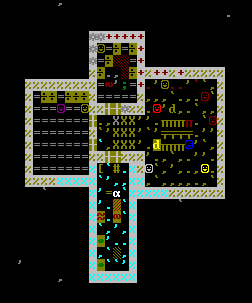- v50 information can now be added to pages in the main namespace. v0.47 information can still be found in the DF2014 namespace. See here for more details on the new versioning policy.
- Use this page to report any issues related to the migration.
Difference between revisions of "Dining room"
(Parties don't exist in DF2014) |
|||
| Line 9: | Line 9: | ||
In order to construct a dining hall, first {{k|b}}uild a {{k|t}}able, then use the {{k|q}} menu to designate the table as a {{k|r}}oom. Some players place [[food]] [[Stockpile#Food|stockpile]]s nearby in hopes that this will lessen the time it takes dwarves to grab a bite to eat. | In order to construct a dining hall, first {{k|b}}uild a {{k|t}}able, then use the {{k|q}} menu to designate the table as a {{k|r}}oom. Some players place [[food]] [[Stockpile#Food|stockpile]]s nearby in hopes that this will lessen the time it takes dwarves to grab a bite to eat. | ||
| − | Once a dining hall has been designated, you may {{k|a}}ssign the room to a specific dwarf or further designate it as a meeting {{k|h}}all using the {{k|q}} menu. Dining halls assigned as meeting halls will attract idle dwarves | + | Once a dining hall has been designated, you may {{k|a}}ssign the room to a specific dwarf or further designate it as a meeting {{k|h}}all using the {{k|q}} menu. Dining halls assigned as meeting halls will attract idle dwarves, which may or may not be useful, depending on individual play style. |
An example dining room is shown below. It includes: a dining hall (east), kitchen (north), storage area (west), fishery, butcher's workshop, and tanner's workshop (south). | An example dining room is shown below. It includes: a dining hall (east), kitchen (north), storage area (west), fishery, butcher's workshop, and tanner's workshop (south). | ||
Revision as of 21:13, 21 October 2017
v50.12 · v0.47.05 This article is about the current version of DF.Note that some content may still need to be updated. |
A dining room is a room designated from a table. The assigned room may be either assigned to a specific dwarf or designated as a dining hall. A valuable communal dining hall is an excellent way to reduce stress. Dwarves can still eat at a table and chair without designating it or the room they are in as a dining room, however.
It is also possible to further designate a dining hall as a meeting hall. Dwarves that are on break or jobless will also meet here and become further acquainted.
Constructing a dining hall
In order to construct a dining hall, first build a table, then use the q menu to designate the table as a room. Some players place food stockpiles nearby in hopes that this will lessen the time it takes dwarves to grab a bite to eat.
Once a dining hall has been designated, you may assign the room to a specific dwarf or further designate it as a meeting hall using the q menu. Dining halls assigned as meeting halls will attract idle dwarves, which may or may not be useful, depending on individual play style.
An example dining room is shown below. It includes: a dining hall (east), kitchen (north), storage area (west), fishery, butcher's workshop, and tanner's workshop (south).
Stress considerations
- A good general rule of thumb is to have enough tables and chairs to serve one fifth (1/5) of your fortress population at any given time. Plan ahead for immigrants. More never hurts, but may never be necessary.
- While it might be common sense to put a chair on either side of a table, or even 4 chairs around a single table, in DF one table is only enough for one dwarf. While a dining room of any size is designated from a single table, dwarves will receive negative thoughts from eating at a dining room (or anywhere else) without both a chair and orthogonally adjacent table to themselves. To prevent this, build multiple tables and add a chair or throne next to each table, and make sure any chair will not be paired with the wrong table, and vice versa.
- Since the room quality is determined solely by the total value of all items and furniture, it is possible to make a legendary room simply by having a great many more chairs and tables than you actually need, which will give your mason something to do and give your fort room to grow in the future. Artifacts that can be used in animal and weapon traps, like mechanisms, will add immensely to room value and impress any dwarf that looks at them, even if they are useless where they are placed. Artifacts you can build are a huge boon for this reason.
- The total value of a dining room will affect how happy dwarves get about eating there. Because dining rooms tend to be large and have lots of potentially valuable furniture, it is fairly simple to get incredibly valuable dining rooms that help offset the depression of a dwarf's best friend being torn apart by goblins. Building furniture from valuable materials such as flux, obsidian, or various metals helps. Decorating the walls and floors is also an easy way to make a dining hall more valuable. Try to use an experienced engraver for this important task to maximize room value.
- Dwarves with a table or chair in their quarters may opt to eat their meals there instead of using your magnificent dining hall (forgoing the positive thought and possibly generating negative thoughts as well). To avoid this, do not install tables or chairs in your non-noble dwarves' quarters.
"Dining room" in other Languages
|
Barracks • Bedroom • Dining room • Dormitory • Jail • Meeting hall • Museum • Office • Sculpture garden • Tomb • Zoo |
